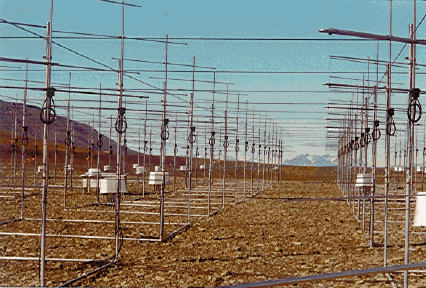
|
SOUSY - Svalbard - Radar
|
 |

|
SOUSY - Svalbard - Radar
|
 |
| Description | |
| Some examples of the SSR operation in 1999 |

The photo shows part of the antenna array, consisting of 356 Yagi elements.
Operating frequency: 53.5 MHz, peak power: 60 kW
Mesosphere-stratosphere-troposphere (MST) radars have proved to contribute significantly to the studies of these processes. For this purpose the Max-Planck-Institut für Aeronomie has constructed and operates an MST VHF radar in Longyearbyen on Svalbard. Such MST radar studies are carried out in combination with other related observations, i.e. with the EISCAT Svalbard Radar for mesospheric and lower thermospheric studies, and with in-situ sounding by rockets (SvalRak) and other ground-based experiments, such as the imaging riometer (DMI) and OH spectrometer (UNIS) performed by several research groups in Longyearbyen. Studies of the Arctic stratosphere and troposphere are in conjunction with observations in Nyålesund and by aircraft performed by AWI.
The SOUSY Svalbard Radar (SSR) of the Max-Planck-Institut für Aeronomie (MPAe), which uses the main basic components of the mobile SOUSY radar, was set up in Longyearbyen in summer 1998. Long experiment operation took place in a few campaigns in 1999. The radar consists of a transmitter operating on 53.5 MHz at peak power of 60 kW (2.4 kW average), a high-gain Yagi-antenna array of 92 meters diameter, allowing five beam pointing directions at and close to the zenith, as well as radar control, receiver and digital signal processing units. This equipment is housed in two containers. The antenna is being modified by separating modules for reception in the radar interferometer and imaging mode.
Some main scientific objectives of this new project SSR, performed by the MPAe, are: Studies of tides, gravity waves and turbulence in the mesosphere and their interaction, the structure and dynamics of Polar Mesosphere Summer Echoes, and studies of Arctic stratosphere-troposphere dynamics related to the formation of Polar Stratospheric Clouds and to stratosphere-troposphere exchange processes.
SOUSY stands for SOUnding SYstem, which indicates that the SOUSY Svalbard Radar is used in a system of instruments to sound the atmosphere.
========================================================================== Location Geographic Date Main Objectives Coordinates ========================================================================== Arecibo, 18 N, 67 W April 1980 - Multifrequency expt., Puerto Rico Dec. 1981 Subtropical Meteorology -------------------------------------------------------------------------- Rosenheim, 48 N, 12 E March 1982 - International ALPEX Germany April 1982 campaign -------------------------------------------------------------------------- Andenes, 69 N, 16 E Nov. 1983 - International Norway June 1984 MAP/WINE campaign -------------------------------------------------------------------------- Cape Canaveral, 29 N, 81 W Feb. 1985 - Wind measurements for USA May 1985 rocket/shuttle launches -------------------------------------------------------------------------- McPherson, 38 N, 98 W April 1985 - Oklahoma-Kansas USA May 1985 PRE-STORM Program -------------------------------------------------------------------------- White Sands, 32 N, 106 W July 1985 - Antenna radiation pattern USA Oct. 1985 Cn^2, Wind -------------------------------------------------------------------------- Lindau, 52 N, 10 E Aug. 1986 Dual radar experiment Germany Reynold stress -------------------------------------------------------------------------- Andenes, 69 N, 16 E June 1987 - International MAC/SINE Norway March 1990 and MAP/EPSILON campaigns -------------------------------------------------------------------------- Andenes, 69 N, 16 E June 1994 - ALOMAR SOUSY Norway March 1998 -------------------------------------------------------------------------- Svalbard, 78 N, 16 E June 1999 - SOUSY Svalbard Radar (SSR) Norway present ==========================================================================
Transmitter:
-----------
Frequency ........................... 53.5 MHz
Pulse Peak Power .................... 60 kW
Duty Cycle .......................... 4%
min. Pulse Length ................... 1 microseconds
Antenna:
-------
Single Element ...................... 4-element Yagi
Number of Elements .................. 356
Beamwidth ........................... 4.5 degrees
Gain ................................ 33 dBi
Pointingdirections :
vertical, 5 ° to NE, SE, SW, NW
Separable into modules
| © 2006, Max Planck Institute for Solar System Research, Lindau |
Rüster 21-01-2000 |